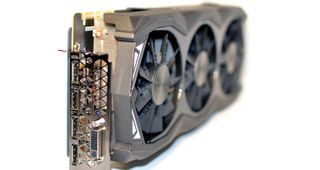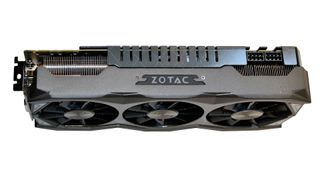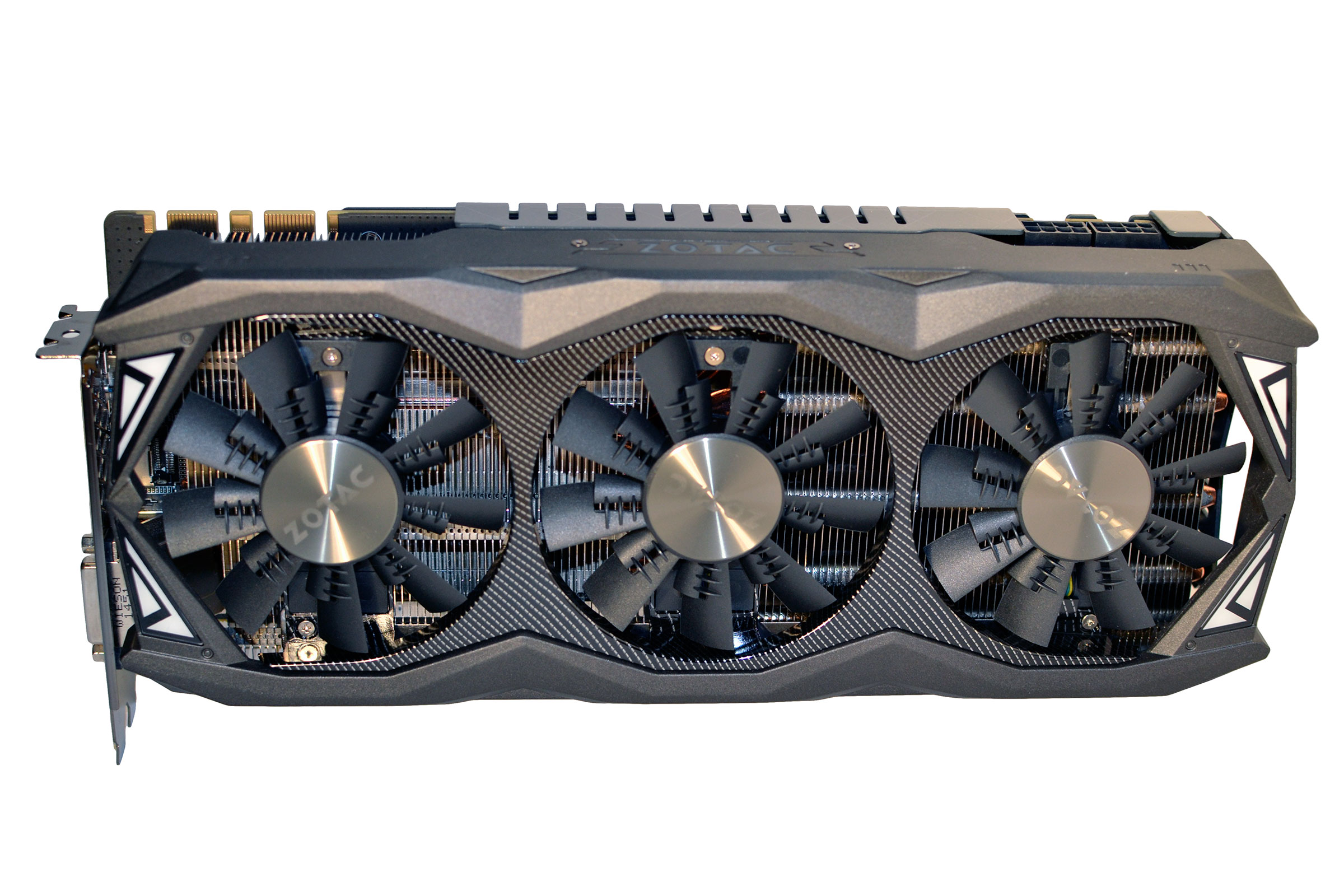Our Verdict
Zotacs 980 Ti Amp! Extreme lives up to its name and tops our single-GPU performance charts.
PC Gamer's got your back
(+) Bigfoot: Awe-inspiring performance; massive overclocks; great cooling.
(-) Smartcar: Pricey; requires lots of space; higher power requirements.
Taking a triple-wide GPU for a spin
Remember the days when graphics cards were called video cards, they used to spit out a whopping 256 colors (or 16 or even 4 colors/monochrome if you go back far enough), and they occupied a single expansion slot? Sure, smaller cards continue to exist even today, but the last halo GPUs to launch in single-slot variants were Nvidia’s 7800 GTX and ATI’s Radeon X800 XT. People complained when we went from single-wide to double-wide about the loss of an expansion slot, but today, just about every GPU in the midrange or higher performance bracket will occupy two expansion slots.
This has all been done in the name of keeping things cool and quiet, since adding a larger heatsink and fan generally makes it easier to keep temperatures and noise in check. And when we consider the latest GPUs can require up to 275W of power, that’s no mean feat. Zotac takes things one step further, with their triple-wide Amp! Extreme series. The latest addition is a 980 Ti GPU, though Zotac first used triple-wide coolers as far back as the GTX 580. There’s only one real question: Does the added bulk provide more performance? In a word, yes.

Not everyone is going to want a triple-wide GPU, but if you have no intention of running additional expansion cards and you want the fastest factory clock around, Zotac appears to win that contest (by 50MHz, if you’re wondering). Their Amp! Extreme comes with a 25 percent GPU overclock, which is actually higher than we were able to push our reference 980 Ti card. As if that’s not enough, Zotac bumps the GDDR5 clocks up three percent over stock as well, making this one of the few 980 Ti cards to ship with overclocked RAM.
If you’re looking at the pictures of this mammoth card and thinking they look a bit tame, we agree! We have a monster GPU cooler just waiting to be pushed to the limit, and 1253/7220 is most definitely leaving some untapped potential for us to explore. Bearing in mind that end-user overclocking results will vary, we pushed the fan speed up to 100 percent (which still isn’t overly loud) and managed to run through all of our gaming benchmarks with settings of 1300/8250 (with a +87mV bump to voltage). [Note: GPU Boost is still enabled, which means the Boost clock is typically at 1400MHz or more.] Now that’s an overclock worthy of three slots! Wait until you see the resulting performance….
Here’s a quick overview of the current high-end GPU specs from Nvidia, with Zotac’s card for comparison:
| Zotac vs. Nvidia High-End GPU Specs | |||||
| | Zotac 980 Ti Amp! Extreme | GTX Titan X | GTX 980 Ti | GTX 980 | GTX 970 |
| Generation | GM200 | GM200 | GM200 | GM204 | GM204 |
| Core Clock (MHz) | 1,253 | 1,000 | 1,000 | 1,216 | 1,088 |
| Boost Clock (MHz) | 1,355 | 1,075 | 1,076 | 1,317 | 1,228 |
| VRAM Clock (MHz) | 7,220 | 7,010 | 7,010 | 7,000 | 7,000 |
| VRAM Amount | 6GB | 12GB | 6GB | 4GB | 4GB |
| Bus | 384-bit | 384-bit | 384-bit | 256-bit | 256-bit |
| ROPs | 96 | 96 | 96 | 64 | 56 |
| TMUs | 192 | 192 | 192 | 128 | 104 |
| Shaders | 2,816 | 3,072 | 2,816 | 2,048 | 1,664 |
| SMs | 22 | 24 | 22 | 16 | 13 |
| TDP (watts) | 275 | 250 | 250 | 165 | 145 |
| Starting Price | $670 | $1,000 | $620 | $470 | $290 |
One thing worth pointing out before we continue is that pricing on all of Nvidia’s high-end GPUs has dropped quite a bit over the past few months. It’s amazing what a little competition can do, eh? We can thank AMD’s R9 Fury X, R9 Fury, and R9 Nano for pushing things below MSRP on virtually all high-end GPUs. If you’re willing to deal with mail-in rebates, in some cases you can go even lower. While we wait for the 16nm FinFET GPUs to roll out next year, the current crop of cards will happily provide great gaming performance.

Taking a closer look at the Zotac card, there are a few items of note. First, of course, is that triple-slot GPU cooler we’ve already discussed. The expansion port bracket still uses two slots, but the cooler itself pushes well into the adjacent space and makes installing anything in the third slot impossible. That means for multi-GPU use, your options are pretty limited. If you have cards spaced far enough apart, you can still do 2-way SLI, which would eat up the space of six slots. The only way you’re going to manage 3-way or 4-way with the Amp! Extreme is if you’re willing to use PCIe extension cables with a custom case, neither of which is something we’d recommend for most users.
The second thing to point out is that Zotac has equipped the Amp! Extreme with two 8-pin PEG connectors, ensuring adequate power delivery for the card and providing the additional overclocking headroom we’ve already discussed. Trust us: you need the added power. Our reference 980 Ti under load used 380W in our power testing, while at factory clocks the Zotac Amp! Extreme pulls as much as 456W. With our aggressive overclocks, things are even more intense, peaking at over 500W. Considering the rest of the system accounts for roughly 220W of power use under load, the move to dual 8-pin connectors may not have been absolutely necessary, but for the target market of overclocking enthusiasts it was definitely smart.
Monster GPU Madness
We’ve talked about the high factory overclock as well as our even more aggressive overclocks. Now it’s time to see what that actually means when it comes to playing games. We’re using our standard GPU test bed, running a healthy overclock on the CPU as well to eliminate other potential bottlenecks (as much as possible). Here are the specs for our test cards, followed by the benchmarks:








The two fastest GPUs right now are from Nvidia: the GTX Titan X and GTX 980 Ti. In many cases, the difference between the two in raw performance is negligible, which means clock speeds can really shake things up. With a 25 percent factory overclock, the Zotac 980 Ti Amp! Extreme easily takes the crown as the fastest GPU we’ve tested. It beats the stock-clocked 980 Ti by 14 percent on average, or the stock GTX Titan X by 12 percent. With additional overclocking, we’re able to tack on another eight percent. Cycling through our games doesn’t affect things; with dirt spewing from its oversized tires, Zotac’s monster truck of a GPU crushes the competition flat.

Guzzling Gas
One thing we’ve learned recently with the release of the Mad Max video game is that, when the world ends, having the biggest, brawniest engine possible will be the difference between life and death. Max would definitely appreciate Zotac’s GPU, and he’d use it to set his enemies on fire. The only real issues with the Zotac card are its sheer size, which requires not just three slots but twelve inches to fit the card into your case. Needless to say, there are plenty of standard ATX cases that simply won’t have room for the Amp! Extreme, though most full-size ATX cases should be okay—make sure the card will fit before buying, though. Power requirements are also higher, and we’d recommend having at least a 750W PSU to be safe, but those are readily available.
Zotac’s beastly GPU ends up being the antithesis of AMD’s R9 Nano. Where AMD’s engineers targeted making the smallest GPU possible, Zotac wonders how big enthusiasts are willing to go. This is the fourth time the company has trotted out its supersized cooler, which indicates there’s enough of a market niche here that it’s worth the efforts. We’ve already awarded Nvidia’s GTX 980 Ti a 95/Kick-Ass, and that applies to all of the 980 Ti cards out there (provided they don’t fail miserably in some fashion). The Amp! Extreme will be more GPU than many people need or even want, but if you have space in your case and you only intend to use a single GPU (or at most two), it takes the crown for out-of-box as well as overclocked performance.
Follow Jarred on Twitter.
Zotacs 980 Ti Amp! Extreme lives up to its name and tops our single-GPU performance charts.
Jarred's love of computers dates back to the dark ages when his dad brought home a DOS 2.3 PC and he left his C-64 behind. He eventually built his first custom PC in 1990 with a 286 12MHz, only to discover it was already woefully outdated when Wing Commander was released a few months later. He holds a BS in Computer Science from Brigham Young University and has been working as a tech journalist since 2004, writing for AnandTech, Maximum PC, and PC Gamer. From the first S3 Virge '3D decelerators' to today's GPUs, Jarred keeps up with all the latest graphics trends and is the one to ask about game performance.
